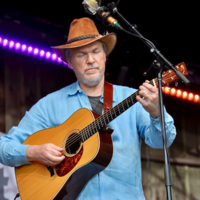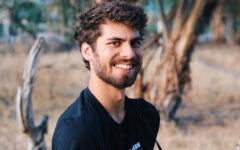
Mark & Maggie O’Connor on Watson Stage at Merlefest on April 28, 2019 – Photo by Alisa B. Cherry
Mark O’Connor is a phenomenon. That’s not a label to be taken lightly. With 45 albums of his own recorded over the expanse of 45 years, and his name on the credits of 450 recordings overall, he’s easily one of the most prolific artists still working today. It’s an intrinsic element in his career that’s been evident since the beginning. At age 13, he won the Grand Masters Fiddle Championships in Nashville sponsored by WSM radio and the Grand Ole Opry, and in competing with entrants of all ages, he became one of hte youngest people ever to do so. That same year, he won the National Flat Pick Guitar Championship held in Winfield, Kansas. Then, when he turned 19, he took top prize in the Buck White International Mandolin Championship in Kerrville, Texas. Add to that his quadruple wins at the National Oldtime Fiddler’s Contest in Weiser, Idaho, and all indications are that O’Connor. was a child prodigy in the truest sense.
That succession of accolades has continued ever since. A three-time Grammy Award winner, he was also named Musician of the Year by the Country Music Association six years in a row. Yet his achievements haven’t been limited to any particular genre. Although he’s known mostly in bluegrass and grassicana circles, his efforts have extended to classical, folk, and jazz idioms as well. He’s worked with some of the world’s most prestigious musicians in all realms of his work — Yo-Yo Ma, Stephane Grappelli, Edgar Meyer, and James Taylor, not to mention the two bands that he played an integral part in, the Dixie Dregs and the supergroup, Strength in Numbers.
These days, O’Connor is involved in a continuing array of projects, including his Grammy- winning family band, featuring his wife Maggie (fiddle, vocal), son Forrest (mandolin, vocal), daughter-in-law Kate (fiddle, vocal), guitarist Joe Smart and bassist/banjo player Geoff Saunders. The group’s rousing recent album Live! offers an ideal insight into their prowess, ability and close-knit cohesion.
In addition, O’Connor created a string instrument technique dubbed The O’Connor Method – A New American School of String Playing, one that emphasizes playing techniques that focus on rhythmic development, ear training, and improvisation, all from the prospective of an American overview.
We caught up with O’Connor at MerleFest a few weeks ago, where, playing in a duet with his wife Maggie, he made his return after an absence of some 15 years. The two were celebrating their aptly named 2015 album Duo album, resulting in a spectacular performance at the festival’s main venue, the Watson Stage. O’Connor graciously took time to talk to us about his career, his childhood, and the many projects that continually seem to occupy his plate.
BLUEGRASS TODAY: You’re so prodigious. You average an album release every year. And on top of that, you segue between genres with such ease and consistency as well. You vary your palette between bluegrass, traditional music, classical music, jazz, and seemingly every style in-between.
MARK O’CONNOR: This year I’m celebrating my 45th year as a recording artist. I’m 57, and I started recording when I was 12. At that age, I was the youngest artist to ever sign with Rounder Records, or for that matter, any record company. Even when I was in my twenties and I signed with Warner Bros. as an artist/producer, I was the youngest artist/producer ever signed, other than Prince. I’ve had really great opportunities, and I certainly had a lot of ideas from the very beginning. Obviously it really helps when people express interest in your ideas, and then give you a budget to do them. So I put extra time in because there was a budget and I was able to pay myself some rent money. I realized that the way I played the instruments — the violin and the guitar primarily — allowed me to create a bridge to various genres.
And yet, you’ve never been bound to any one instrument.
I realized that I was getting all these violin fans listening to what I was doinge. There was something that they were hearing in the music that attracted them, so that led me to start playing classical music in an improvisational setting. There was already a bridge being created just by the style and the technique that I was developing on the instrument. I just wanted to go where my heart led me every time. Then I was able to work with musicians like Yo Yo Ma. There wasn’t even a project to begin with, but we had an idea.
Just an idea?
There was no record, project, anything. Just an exchange of ideas and he loved that, and that led us to create a pair of albums Appalachian Waltz and Appalachian Journey.
You’ve worked with some great musicians indeed.
I’ve been really grateful to have a lot of help along the way. There were other albums where I took the bull by the horns, and they became labors of love from different angles. Still, I could never really count on the support very long, so I’m always thinking about creating the next project around the music that I was composing or arranging. I do love the classics, so I do a lot of arranging around the classics material. I do a lot of composing, so whatever I end up writing I have to figure out a way to get other people involved. I reach out to other musicians, and if I can get the support, then boom, we’re in a recording studio, or more commonly, in a concert hall recording it in there. I love the sound of a great concert hall.
So when you delve into traditional American music, do you go for the backstory? Would you consider yourself an archivist of any sort? Do you spend a lot of time studying these different genres?
Yes. I was very, very fortunate to have great teachers — Stephane Grappelli being one — and a whole host of other mentors beyond that. So I was kind of like a mini-me musicologist right from the beginning. As a kid, I learned the stories and the histories of the music. I was playing blues at the age of eleven. I just gravitated to these old, traditional Americana music styles that really fed my later music output. And being around people like Earl Scruggs or Marty Stuart or B.B. King — all the fiddlers, all the guitar players — really encouraged me. I was drawn to flatpickers and they became like older brothers, like Merle Watson was, or a father figure, like Doc Watson became. My mentors and teachers would always turn a lightbulb on. They would inspire my muse and encourage me to develop my own style. They would teach me everything they knew, but would tell me not to be a carbon copy of them. I’d want to do it exactly like them, but they knew I always had my own track. So I was trying to come up with a new way to play the American violin. I was influenced by people like Johnny Gimble and Vassar Clements and Byron Berline, and they had their own style. That was the creative part of my musical journey, and it inspired all these albums and all these projects, including my family band.
That seems to be playing a predominant role in the music your making now. Tell us a little about that.
It allowed me to rediscover my earlier work that inspired my children when they were growing up. I was their soundtrack. Now I’ve come full circle by playing with my family the music I was sharing with them in the late ‘80s and early ‘90s.
What’s especially impressive is that as a child, you won championships on every instrument you played — guitar, fiddle, mandolin. How does that happen? You were 13 at the time.
I look at my life in a sequence of eras. My teenage era is unexplainable. I can’t even explain it. The music was in front of me, and I knew I knew it. But it was different than the typical prodigy, which is sometime very mechanical. I was coming up with my own arrangements and thriving on my own creativity at 13. It wasn’t like I was told, “Play this rendition and you’ll win this contest.” I was literally making it up as I went along. So for me I had to move on from it and become an adult. I matured. If I just remained a player, I don’t know if I would have been able to channel it in a way that made sense to me. I just channeled it all into my emotions, my experiences, and while everyone was marvelling over what I was doing as a kid, I had struggles in other parts of my life at the same time. With my school life, my family life. At one point, I wanted to run away from home. Music was an escape from what was a tragic situation in a way, and it was waiting for me as soon as I picked up an instrument, and I was able to put smiles on people’s faces.
Were you hearing music in your household when you were growing up?
I was surrounded by the arts. My grandmother had a healthy record collection, so I was listening to everything from the Stanley Brothers to Johnny Cash. I was enamoured with acoustic music. I started to play more electric while I was in high school, but for the most part, I had to come south in the summer to be around my mentors. I’d go to festivals and I’d learn. I learned a lot. And then I’d woodshed and dream about the next summer season when I could be around all these great bluegrass players again. It was unusual that there was a child playing this music. Now it’s much more common.
You’ve fostered that through your camps and workshops, have you not?
We’ve fostered students at our camp over the course of the past 20 years. We focus on all the strings, and string orchestra, and solo studies. We focus on American music and cultural diversity within all the strains of American music, music from all eras, even back as far as 400 years. There’s never really been a formalized American method. There’s been the European method and a Japanese method, but the O’Connor Method celebrates American culture, which is now really the world culture.
Let’s talk a bit about the O’Connor family band efforts. You recorded the first album in 2016. Some folks might think that a family situation like that is easy and natural, but it doesn’t always turn out that way, does it?
I hear what you’re saying. There’s so much love between the O’Connors, and there’s so much love of the music that we play and share. And in addition, there’s so much love of the history of the music that I played, which inspired them. So there was so much reason to do this. But logistically, it’s interesting. My son Forrest and I have always been extremely close. In some ways, he’s like my best friend. I look at him like a colleague. He’s so gifted and so smart. I learn from him and from the younger people in my family as well. I’m just here to show them how everything goes. At the same time, I’m still growing and learning as well. I’ve never had such a good time, and I’ve played with some of the top people in the world. I consider it my responsibility to be good for them, to help them, to help them in their career. When I played with other people, I wanted to earn my keep and to be sure I was always hitting the high bar. But now, there are times when I can’t wipe the smile off my face. I’m really kind of a stoic performer. I want to deliver a performance that’s very thought out in a way that puts my best foot forward, something that I can be proud of. But now, I get to be proud of my family members.
It seems like it’s a very democratic process, because the credits are shared among all of you.
Yes. Everyone takes a turn leading the songs. My son was the producer. Without the three couples, someone would have felt like the third wheel. But the sharing of this beautiful music that we all grew up listening to makes it feel like we’re all colleagues. That really set it all in motion.
Was this a natural transition from your family gatherings where you would all sit around and share music?
It was. Everybody in the family is very nice and very confident. They can get out and just deliver time after time. They have an uncanny professionalism about them, and I don’t know where that comes from, because I still get nervous before I perform. There’s a lot of emotion I feel in my performances, and I’m very vulnerable to that. I was nervous today. I hadn’t been back here in many years.
It appears you’re very satisfied with the status quo at this point.
As leader of this band, my leadership steers this band to play better. Everybody in the O’Connor Band is very virtuosic and it’s rare to have that level of talent all in one band. I’ve played with some great players, and there was a mix of talent, but when we play together, we all sound great. We sounded great on our own, and pretty good together, but that’s where my leadership comes in to make sure we sound great together. A year and a half ago, I couldn’t have imagined we are the band that we are now. I had to keep telling everybody to listen to one another. I want you to know what we’re going to do before we even do it. It’s a kind of telepathy, an intuitive instinct. We had to reach down to find the culmination of our journey, and when we finally got there, we played at a small room, a tiny hole in the wall, so we could really get tight. I said, forget about yourselves, think about playing with others, and we learned how to do it, that’s when we decided to record a live album. And we knocked it out of the park that night. It’s actually one of my favorite albums. I really like recording live, either in a concert hall or a recording studio.
You put on a fantastic show with just you and your wife up there on stage.
It’s unbelievable. You don’t see that many duos, but we have an obvious chemistry. We’re tapping into something and I can’t even explain it. I feel it though.
It was impressive just to see the two of you, playing mostly instrumental music and still holding the attention of the crowd. That’s not an easy thing either. Especially with two violins. That’s very impressive.
I was a little apprehensive about it going in, but then I thought, maybe everybody’s ready for a change. And now I’m here after 15 years and seeing more of a rock sound, with bass and drums. That’s something different. So after being here a few days, it’s given me time to recalculate. This is a music-loving audience. It’s more than a rock and roll audience. There might be something that we do that gets their support. We’ve certainly never played as a duo on this big a stage before. We’ve always done it in concert halls, but I think it sounded golden here. You can feel when it sounds right. Some people may not understand the difference, but it’s an emotional response for most good. If it feels good, it usually sounds good.










